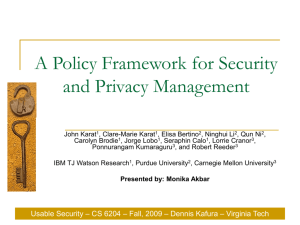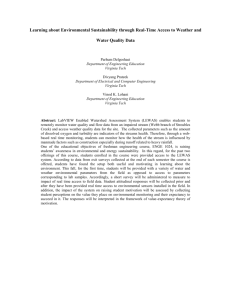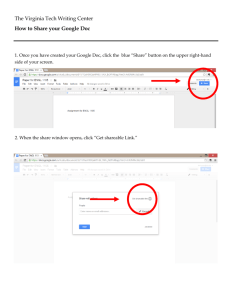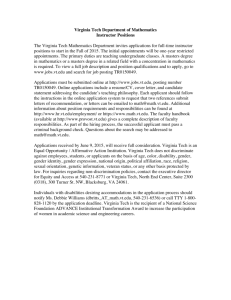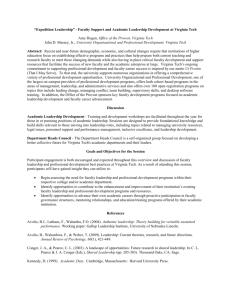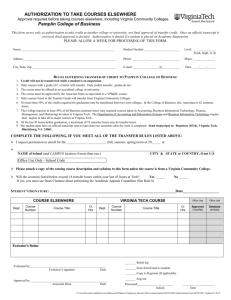PPT - Virginia Tech
advertisement
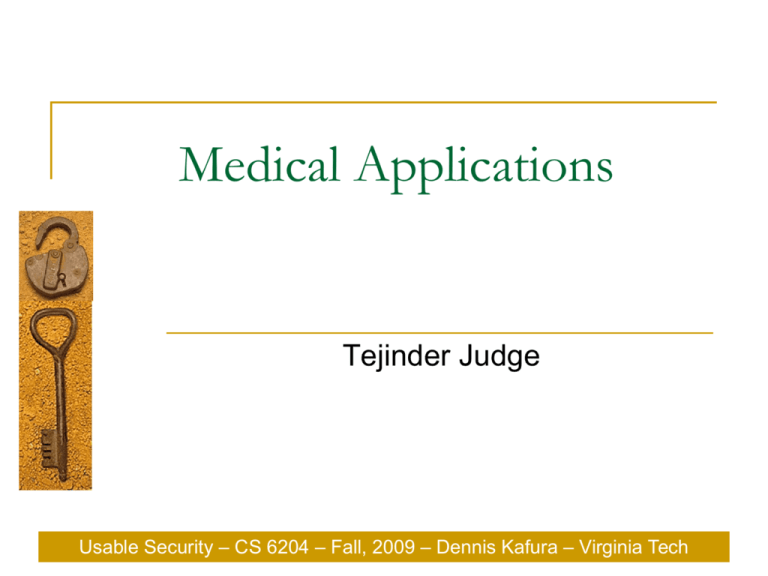
Medical Applications Tejinder Judge Usable Security – CS 6204 – Fall, 2009 – Dennis Kafura – Virginia Tech Jacob Bardram Professor at University of Copenhagen His research areas are Ubiquitous Computing, Computer Supported Cooperative Work (CSCW), and HumanComputer Interaction (HCI) Main application area of this research is healthcare, especially Pervasive Healthcare Usable Security – CS 6204 – Fall, 2009 – Dennis Kafura – Virginia Tech Central theme of these papers The main challenge in the shift from desktop computing, to ubiquitous and pervasive computing, is user authentication A domain where this challenge is easily seen is healthcare Usable Security – CS 6204 – Fall, 2009 – Dennis Kafura – Virginia Tech Paper 1 Context-Aware User Authentication – Supporting Proximity-Based Login in Pervasive Computing Jakob Bardram, Rasmus Kjær, and Michael Pedersen Proceedings of Ubicomp 2003 Usable Security – CS 6204 – Fall, 2009 – Dennis Kafura – Virginia Tech Motivation Problems with Electronic Patient Records (EPR) Clinicians have to log in 20-30 times a day Have to log on to different machines based on location Made easy to share passwords like ‘1234’ Usable Security – CS 6204 – Fall, 2009 – Dennis Kafura – Virginia Tech Activity-Based Computing The basic idea is to represent a user’s (work) activity as a collection of computational services Make such activities available on various stationary and mobile computing equipment in a hospital Clinicians can initiate a set of activities, and access these on various devices in the hospital Usable Security – CS 6204 – Fall, 2009 – Dennis Kafura – Virginia Tech Method Participatory design sessions and workshops 12 workshops, 4-6 hours each with 6-10 participants (most of which were clinicians) Several user authentication mechanisms were designed implemented and evaluated Usable Security – CS 6204 – Fall, 2009 – Dennis Kafura – Virginia Tech Requirements for a pervasive computing user authentication mechanism Proximity based Secure Active gesture Support for logout Usable Security – CS 6204 – Fall, 2009 – Dennis Kafura – Virginia Tech Context-aware user authentication 3 key principles First, it uses a physical token used for active gesturing and as the basis for authentication Second, it uses a context-awareness system to verify the location of the user, and to log out the user when she leaves a certain place Third, it contains ‘fall-back’ mechanisms, so that if either of the two components in the system falls out, the user authentication mechanism switches to other mechanisms. Usable Security – CS 6204 – Fall, 2009 – Dennis Kafura – Virginia Tech Authentication protocol The authentication protocol runs on a JavaCard The following information is stored on the card: An id for the user the card belongs to. The user’s password. The user’s pair of a secret key (KS) and public key (KP). Usable Security – CS 6204 – Fall, 2009 – Dennis Kafura – Virginia Tech Authentication protocol 1. The client receives notification that user P is in the room (optional). 2. The user places his smart card in the card reader. 3. The client requests the id from the smart card. 4. The client looks up the person in the Context Server based on the id from the card. Usable Security – CS 6204 – Fall, 2009 – Dennis Kafura – Virginia Tech Authentication protocol 5. There are two distinct cases based on the probability that the user is in the same place as the client. Case A: The probability is greater that a certain threshold. The smart card is asked to verify that it holds the user’s secret key, KS. Case B: The location of the user is not sufficiently sure. The computer asks the user to enter his password. The smart card accepts or rejects the user based on the password. Usable Security – CS 6204 – Fall, 2009 – Dennis Kafura – Virginia Tech Infrastructure Context Context Monitors Context Server Client 1 Client 2 Usable Security – CS 6204 – Fall, 2009 – Dennis Kafura – Virginia Tech Security analysis It is possible for someone to authenticate as a legitimate user by the following: 1. Steal the smart card and fake the location of a legitimate user 2. Steal the smart card and be in the same room as the legitimate user. 3. Steal the smart card and acquire the user’s password somehow Usable Security – CS 6204 – Fall, 2009 – Dennis Kafura – Virginia Tech Possible solutions Voice monitor that can identify and locate a user based on voice Additional checks (e.g. is user still on his shift?) Using biometrics instead of a password Usable Security – CS 6204 – Fall, 2009 – Dennis Kafura – Virginia Tech Paper 2 Applications of context-aware computing in hospital work: examples and design principles Jakob Bardram Proceedings of the 2004 ACM Symposium on Applied Computing Usable Security – CS 6204 – Fall, 2009 – Dennis Kafura – Virginia Tech Motivation Addressing the problems of clinical computer systems being unaware of their usage context Example Electronic Patient Records (EPR) Same interface is used in the ward, operating theater, medicine room Doctors and nurses need to manually adjust the interface. Usable Security – CS 6204 – Fall, 2009 – Dennis Kafura – Virginia Tech Method Design and implementation of context-aware clinical applications Context-aware Electronic Patient Records (EPR) Context-aware pill container Context-aware hospital bed Design was a result of 15 workshops over 2 years Each workshop was 4-7 hours, had 5-12 participants each 8 participants were clinicians Usable Security – CS 6204 – Fall, 2009 – Dennis Kafura – Virginia Tech Scenarios of context-awareness in hospitals Usable Security – CS 6204 – Fall, 2009 – Dennis Kafura – Virginia Tech Prototype of context-aware hospital bed The bed has an integrated computer, a touch sensitive display, various RFID sensors The patient is identified using RFID tags in an armband and the personal profile is loaded into the computer The Context-Aware Hospital Bed. Usable Security – CS 6204 – Fall, 2009 – Dennis Kafura – Virginia Tech Prototype of context aware pill container Current implementation is based on RFID technology The Context-Aware Pill Container. a – the vision with fingerprint recognition and a LED indicating proximity to the patient. b – the current prototype based on RFID technology. Usable Security – CS 6204 – Fall, 2009 – Dennis Kafura – Virginia Tech Lessons learned Context-awareness is particular useful for user-interface navigation Context is more than location Physical things reveal activity Using context-awareness to suggest courses of action Usable Security – CS 6204 – Fall, 2009 – Dennis Kafura – Virginia Tech Design principles Framework for context awareness in medical work 1. Runtime Infrastructure 2. Programming Framework (API) Usable Security – CS 6204 – Fall, 2009 – Dennis Kafura – Virginia Tech Runtime Infrastructure Distributed and Cooperating Services Security and Privacy Lookup and Discovery Extensible Usable Security – CS 6204 – Fall, 2009 – Dennis Kafura – Virginia Tech Application Programmer Interface Semantic-free modeling Context transformation Context quality Support for activities Usable Security – CS 6204 – Fall, 2009 – Dennis Kafura – Virginia Tech Future work Creating a Java Context- Awareness Framework (JCAF) that addresses these design principles Usable Security – CS 6204 – Fall, 2009 – Dennis Kafura – Virginia Tech Paper 3 Security in Context - Lessons Learned from Security Studies in Hospitals Jakob Bardram CHI 2007 Workshop on Security User Studies: Methodologies and Best Practices Usable Security – CS 6204 – Fall, 2009 – Dennis Kafura – Virginia Tech Motivation Conventional login procedures cause usability problems especially in a hospital setting User studies show that the use of cryptic passwords made users write the passwords on the computer displays Usable Security – CS 6204 – Fall, 2009 – Dennis Kafura – Virginia Tech Proposed solution User-centered security that has usability as a primary goal Usable Security – CS 6204 – Fall, 2009 – Dennis Kafura – Virginia Tech Current security challenges Collaborating using an EPR No longer easy for nurses to work together around digitized records Technological challenge: is to enable users to share’ a login, i.e. enabling some kind of collective user authentication. Usable Security – CS 6204 – Fall, 2009 – Dennis Kafura – Virginia Tech Current security challenges User authentication in the design of home monitoring devices for the elderly An elderly lady has severe problems of using the tablet PC and did not succeed in authenticating herself to the system using the finger print scanner Usable Security – CS 6204 – Fall, 2009 – Dennis Kafura – Virginia Tech Prototype of proximity-based user authentication mechanism The overall goal with this proximity-based user authentication technology was to log in the user when he or she approached a computer, like a large public display. Usable Security – CS 6204 – Fall, 2009 – Dennis Kafura – Virginia Tech Evaluation of prototype and results Logging in a person by proximity might not work in a real hospital Authentication needs to be triggered by some gesture from the user Need fast switching between users “Shift user” command while leaving screen intact Usable Security – CS 6204 – Fall, 2009 – Dennis Kafura – Virginia Tech Lessons learned from multiple security studies Ethnographic field studies are useful in understanding security and usability problems Design security technologies based on what users do not by merely improving existing security technologies Usable Security – CS 6204 – Fall, 2009 – Dennis Kafura – Virginia Tech Lessons learned from multiple security studies Making security more usable is to realize the need for many different kinds of security – one size does not fit all Make security visible and understandable Usable Security – CS 6204 – Fall, 2009 – Dennis Kafura – Virginia Tech Central theme of these papers The main challenge in the shift from desktop computing, to ubiquitous and pervasive computing, is user authentication Usable Security – CS 6204 – Fall, 2009 – Dennis Kafura – Virginia Tech Conclusion and critique Provided two solutions to user authentication Context based authentication Proximity based authentication Provided a domain and justification for using context-aware applications and activity-based computing in a hospital Did not discuss possible pitfalls of using context-aware applications in a hospital Usable Security – CS 6204 – Fall, 2009 – Dennis Kafura – Virginia Tech Discussion What are the tradeoffs to using context based applications in hospitals? How can we design with users who prefer having no security hassle? How can we implement security mechanisms which are sufficiently secure while being usable? How do we evaluate such technologies? Usable Security – CS 6204 – Fall, 2009 – Dennis Kafura – Virginia Tech

